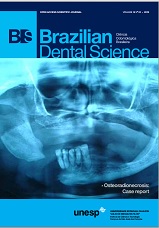Photographic assessment of hyperdivergent class II patients
DOI:
https://doi.org/10.14295/bds.2015.v18i2.1092Resumo
Temporomandibular disorders, sleep disturbances by airway obstruction and craniocervical posture changes constitute some of the problems that have been related to hyperdivergent class II patients. Although cephalometric radiographs represent the gold standard for diagnosing craniofacial morphology in clinical practice, it might not be feasible for large-scale epidemiological research. Objective: The aim of this study was to test the validity of a new photographic method in diagnosing hyperdivergent class II patients for epidemiological research purposes. Material and Methods: Lateral cephalograms and profile photographs were obtained from 123 subjects assigned into two groups. 51 patients comprised the hyperdivergent class II group and the other 72 composed a second group. Discriminant analysis described a mathematical model to better diagnose hyperdivergent class II patients through photographs. Results: A canonical discriminant function composed of two photographic variables correctly classified 85% of the hyperdivergent class II patients during internal validation (p < 0.001). The method showed 83% sensitivity and 73% specificity in external validation procedure. Conclusion: The photographic method may be a feasible and practical alternative for diagnosing the hyperdivergent class II patient, particularly if there is a need for a low-cost and noninvasive method.
Downloads
Downloads
Publicado
Como Citar
Edição
Seção
Licença
TRANSFERÊNCIA DE DIREITOS AUTORAIS E DECLARAÇÃO DE RESPONSABILIDADE
Toda a propriedade de direitos autorais do artigo "____________________________________________________________________" é transferido do autor(es) para a CIÊNCIA ODONTOLÓGICA BRASILEIRA, no caso do trabalho ser publicado. O artigo não foi publicado em outro lugar e não foi submetido simultaneamente para publicação em outra revista.
Vimos por meio deste, atestar que trabalho é original e não apresenta dados manipulados, fraude ou plágio. Fizemos contribuição científica significativa para o estudo e estamos cientes dos dados apresentados e de acordo com a versão final do artigo. Assumimos total responsabilidade pelos aspectos éticos do estudo.
Este texto deve ser impresso e assinado por todos os autores. A versão digitalizada deverá ser apresentada como arquivo suplementar durante o processo de submissão.




























